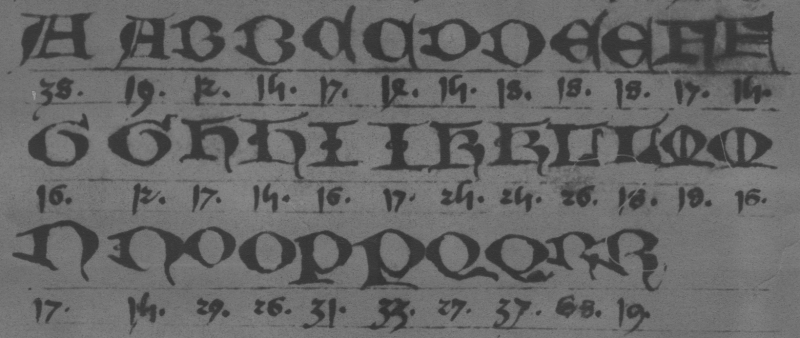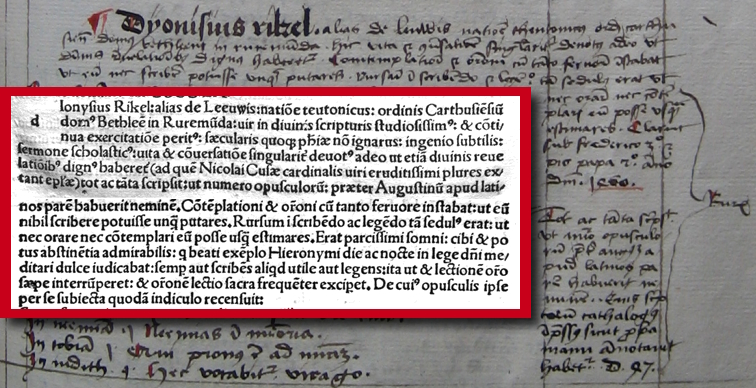Textual Genesis of the Rooklooster RegisterContent of the Rooklooster RegisterIn addition to a Prologus in presens registrum huius nostri monasterii rubeeuallis (fol. 1r°-1v°), the Rooklooster Register contains the following parts. 1. A catalogue of the Rooklooster library (Tabula alphabetica omnium voluminum librarie nostre, fol. 26r°-41v°), preceded by a single parchment leaf with a Canon hic exprimit copiam siue numerum omnium librorum in libraria nostra sub numero certo (fol. 25 v°). This Canon describes the Rooklooster library shelf system using red and black double capitals (ranging from AA to RR), representing the 34 pulpits that were used to store the books. Arabic numbers were put underneath each capital, to represent the quantity of books placed on each pulpit.
These pressmarks were written on parchment (potius in pelle quam in papiro) so that the numbers could easily be scraped when the quantities changed. According to the Canon there were 739 volumes in total. 2. A bibliography of Latin works (occasionally including Latin titles referring to vernacular writings) in the fields of theology, philosophy, spirituality and even classical and humanistic literature. This bibliography may be called 'universal' for several reasons:
3. The main part of the Rooklooster Register consists of three parts:
Dating the Rooklooster RegisterAt some places in the codex, the compiler of the Register dates his work, making it possible to fix the period of its compilation with a certain amount of accuracy: 1532 (fol. 1r°, 371v°), 1535 (fol. 38r°), 1538 (fol. 68r°, 68v°, 211r°, 300r°) and 1540 (fol. 38r°). Therefore we may assume that the Rooklooster Register was composed between 1532 and 1540. The reference tablesAs mentioned above, there are reference marks in the margins of the listed works. These signs refer to the libraries where copies of the mentioned works were available at the time. In two tables these referral signs are explained. 1. The Prima tabula sillabarum (all syllables, except for six characters) is the so-called 'Guelders' list (= list I), featuring libraries located in diuersa loca terre Gelrensis, Coloniensis, Cleuensis, Traiectensis. The exceptional characters in list I are d., y., D. and Q. (without a reference), as well as E. (Embrice in collegio canonicorum [Emmerich]) and h. (heremitarum sancti Augustini monasterium brugis). List I is composed of two halves:
2. The Secunda tabula litterarum (fol. 21r°-21v°) is the so-called 'Brabantine' list (= list II), consisting of small characters and capitals (except for two syllables and five symbols) and referring to 43 libraries of diuersa loca signantur Brabantie, Flandrie, Hannonie, Leodii, Namurcii, Mechlinie (Southern part of the Low Countries). List II exceptionally figures two abbreviated references consisting of syllables: her.: herne ordinis carthusiensis prope geldoniam and Jor.: [Primorum] minorum fratrum bruxelle. The curious presence of the siglum d. (dauentrie domus fratrum clericorum, meaning the Heer-Florenshuis at Deventer) in this table can be explained by the fact that the Domus sanctorum Martini et Gregorii at Leuven, the later priory of Canons Regular belonging to the Chapter of Windesheim, had been a daughter foundation of the Deventer Brethren of the Common Life in 1433. The second reference to this house, i.e. da. (Dauentrie in domo fratrum clericorum de communi vita), correctly figures in list Ia. The five mentioned symbols are those of the Carthusians of Zelem, the Canons Regular of Leuven, and the Minorites, the Augustinian Hermits and the Carmelites of Mechelen (see below in Appendix 2). Author of the Rooklooster RegisterAlthough the author is shrouded in anonymity, there are good reasons to infer that the canon regular Antonius Geens (Gentius, †1543) was the compiler of the Rooklooster Register. During his lifetime, Geens had visited many libraries in an effort to collect a large amount of hagiographic texts. The presence of hagiographic works in the Register suggests his authorship, as does the fact that in 1504 he copied and signed De scriptoribus ecclesiasticis (Basileae, Johann Amerbach, 1494) by Joannes Trithemius O.S.B. (†1516), abbot of Sponheim, an important source for the compilation of the Rooklooster Register. Comparing the handwriting of the Rooklooster Register with that of Geens' copy of Trithemius (Paris, Bibliothèque de l’Arsenal, MS. 507) leaves little room for doubt, at least in the opinion of the Louvain professor W. Lourdaux (†1988) who has studied the copy when he wrote the history of the library of Sint-Maartensdal and its contents (see Research menu: Basic literature). Primary Sources1. For almost all listed works and authors (including the biographical notes), the composer of the Rooklooster Register copied the relevant passages from Trithemius' repertorium. It is difficult if not impossible to say whether the compiler actually consulted the works that are mentioned. In any case, the sumptuous library of Rooklooster would probably have provided a sound basis to draw up the list of works.
2. The most important source, however, was a similar register, originating from the priory of Sint-Maartensdal in Leuven, that has been lost. Around 1487/88, the compiler of this register, the canon regular Gerardus Roelants (†1490), recorded the book holdings in approximately 100 libraries in the region of Germania inferior (i.e. the Low Countries and the Rhineland). This number of libraries more or less corresponds to that of the reference tables in the Rooklooster Register. The compiler of the Rooklooster Register copied out of the Register of Sint-Maarten those items that were not to be found in Trithemius' repertorium. The reference tables were also derived from the catalogue of Leuven, as becomes clear from a few notes: quia copiosus index erat ex quo traxi litteras et sillabas (fol. 1r°) and ex cuius registro hec tabula sumpta est (fol. 21v°). Often the compiler of the Rooklooster Register even slavishly copied the "R."-reference indicating the availability of texts in the Rooklooster library, though he also used the typical Rooklooster reference mark (Ad oculum est videre quod frequentius ponatur hoc signum π per quod signatur nos habere in nostro armario illud volumen ..., fol. 1v°): Gerardus Roelants, the compiler of the Register of Sint-Maarten, had access to a number of earlier catalogues. Trithemius' work would not have been consulted by Roelants, as he died four years before its publication in 1494.
3. Finally, the compiler of the Rooklooster Register used a catalogue (ca. 1525) of the priory of Groenendaal near Hoeilaart to add works that were not mentioned in Trithemius' repertorium. In these cases the Rooklooster Register only refers to the presence of these texts in the Groenendaal library. Here, there is a notable lack of biographical notes and incipits, as this information was not available in the Groenendaal source. 1350 titles from the Groenendaal catalogue were added to the Rooklooster Register. The compiler added these titles only after completing the register, as can be seen from the adjustments to the written space and the use of free space. Some OpinionsThe Rooklooster Register and its predecessors are part of a tradition of book registers going back to the oldest christian book catalogue, Hieronymus' De viris illustribus. In the first place these registers were book-lists of religious literature that were used for the composition of libraries in monasteries and churches. To the lists of authors and works, brief biographical notes, incipits (first few words) and, if necessary, explicits (last few words) were added. Afterwards these registers outgrew their local significance when they were supplemented with information from nearby and remote libraries, thus becoming, to some extent, universal compilations or union catalogues of the most important library catalogues. Frans Hendrickx LiteratureSee the Research menu Appendix 1: Map of the libraries mentioned in the Rooklooster RegisterBased on M. Mittler, Studien zur Geschichte der Siegburger Abteibibliothek, Siegburg, 1974, 27 (= Siegburger Studien, 8)
Legend Appendix 2: Index of the library references in the Rooklooster Register, ordered alphabetically by location and typeThe use of capital and small characters, especially in the abbreviations, is problematic and prone to interpretation and discussion. Some characters were therefore drawn or digitally reproduced. 1 CANONS REGULAR
2 AUGUSTINIAN HERMITS
3 CANONESSES REGULAR
4 BENEDICTINES
5 DOMINICANS
6 FRANCISCAN TERTIARIES Correction 7 BRETHREN OF THE COMMON LIFE
8 CARMELITES
9 CARTHUSIANS
10 CROISIERS
11 MINORITES
12 PREMONSTRATENSIANS
13 COLLEGIATE CHAPTERS
14 UNIVERSITY FACULTY
15 CANONS REGULAR OF THE CHAPTER OF WINDESHEIM
16 CISTERCIANS
|
|







